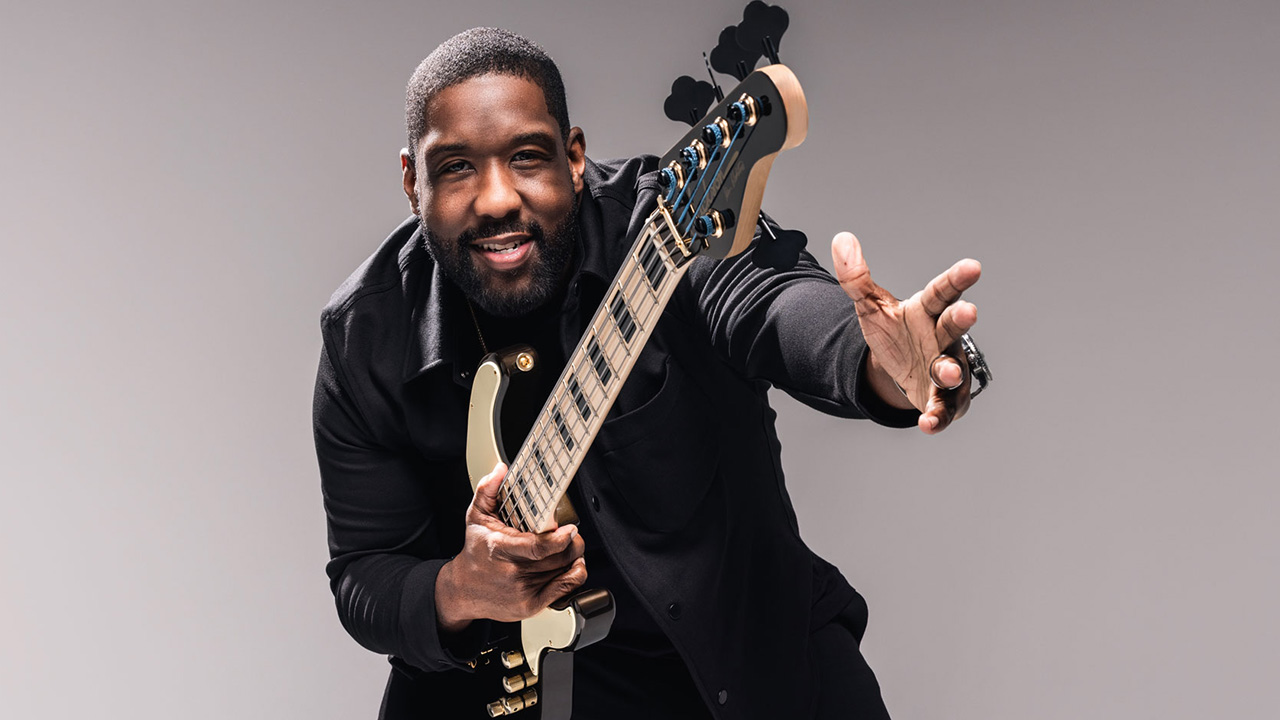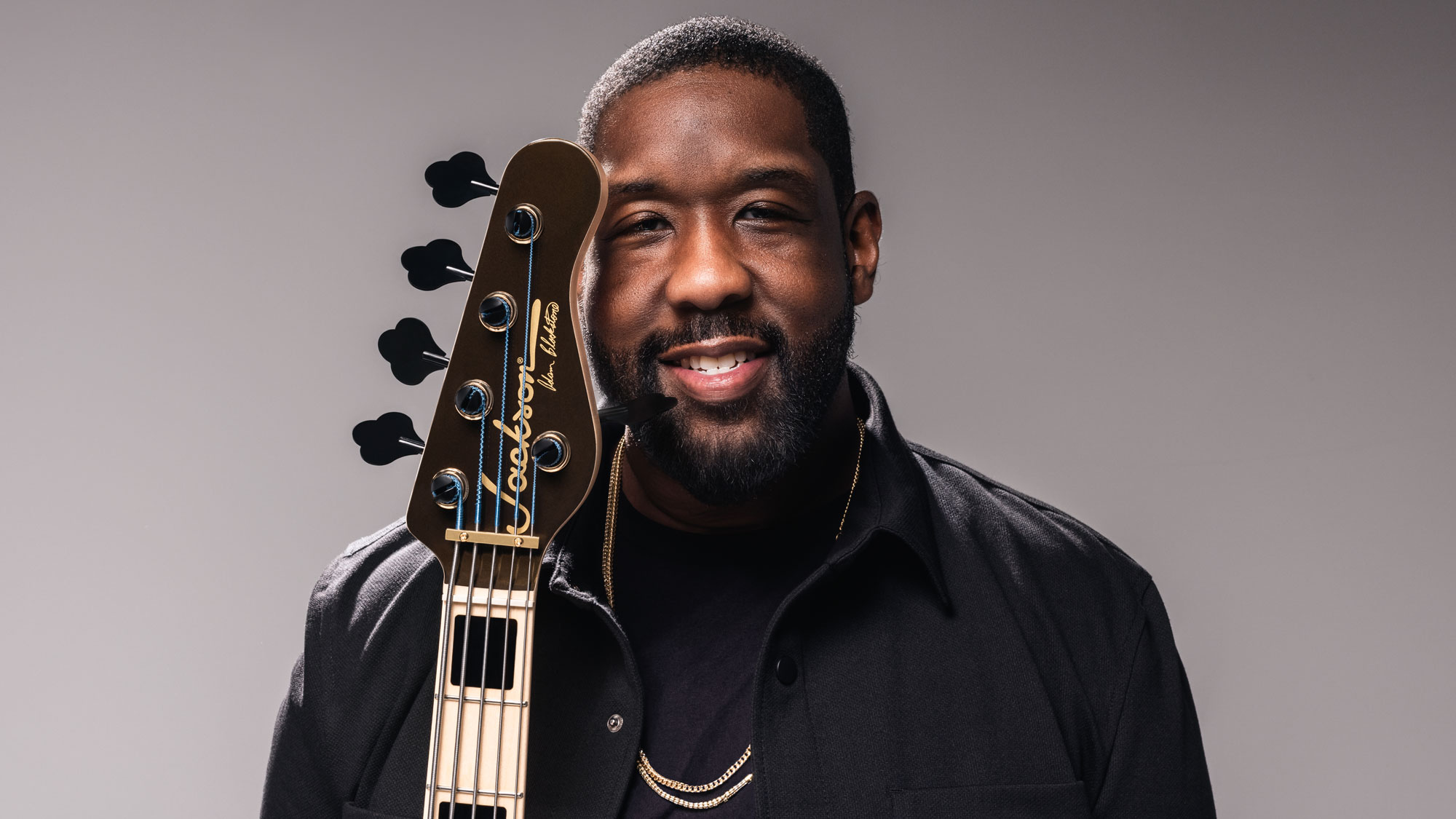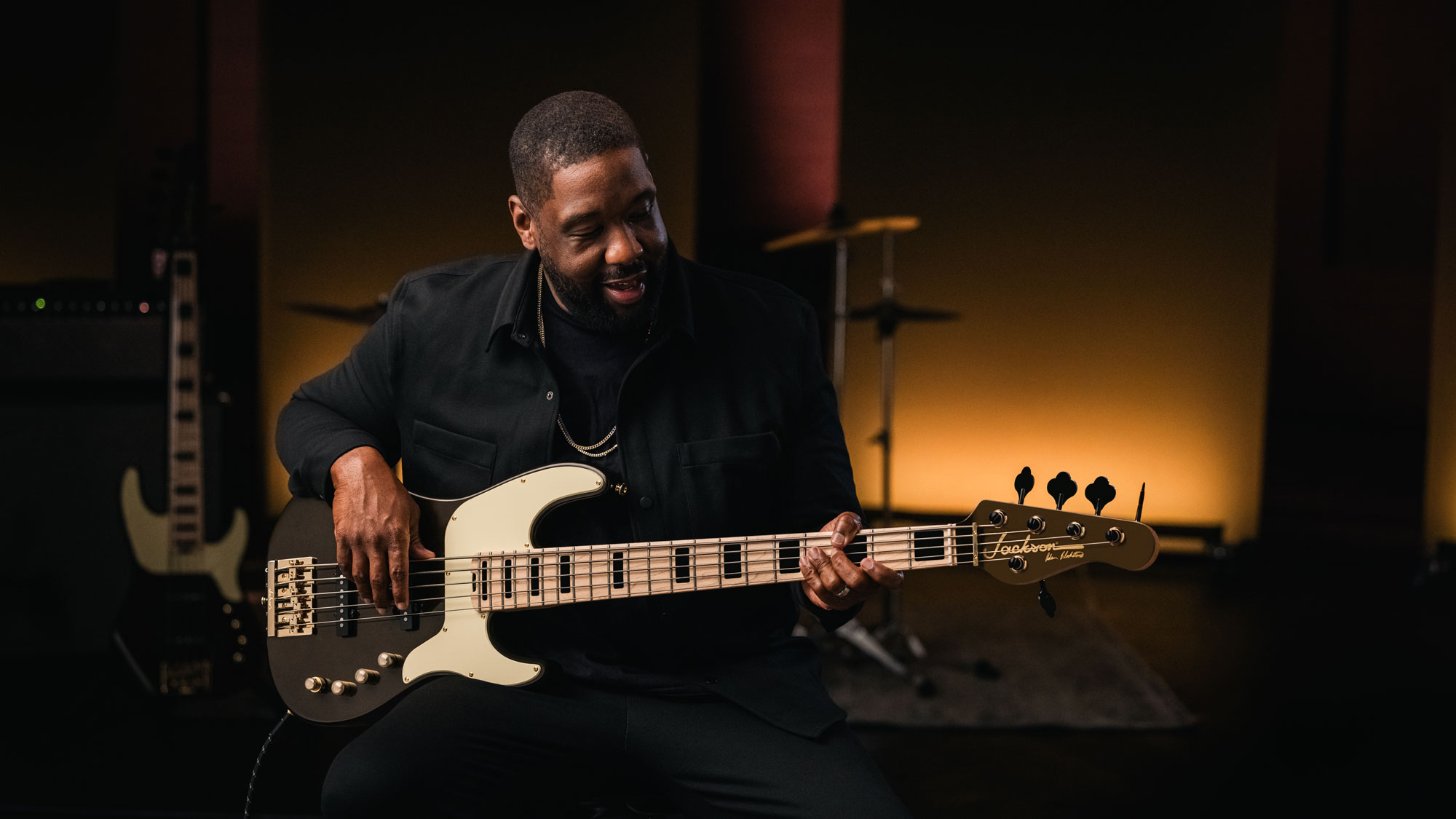
Having worked as a Musical Director for mainstream heavyweights like Justin Timberlake, Rihanna, Eminem and Maroon 5, it would be fair to say Adam Blackstone is a leading authority when it comes to curating engaging live shows.
The Philadelphia session maestro is accustomed to delivering in high-pressure environments such as the Oscars, the Grammys and – most notably of all – the Super Bowl halftime shows, where he’s overseen performances by Shakira and J-Lo, as well as last year’s headline-making Rihanna set.
This year he’s been awarded his first-ever signature five-string through Jackson and, as you’d expect from someone with such a well-rounded musical résumé, it’s an instrument designed with sonic versatility in mind.
Named after his grandmother, the Gladys Pro Series Signature Concert Bass will undoubtedly sit as one of the most eye-catching Jackson models to be unveiled this year, with a striking ’70s-style aesthetic and customizations from Blackstone himself.
But when it’s put it to him that the Jackson branding on the headstock is a surprise, given how the instrument is more spiritually beholden to the Fender Jazz family, he laughs it off. “Don’t be surprised!” he grins.
“First of all, the Jackson and Fender experience today is coinciding. I was excited to be one of the people that represents that through an instrument, because this bass definitely has elements of both.
“It’s obviously a Fender Jazz-style bass in terms of the design and sound. But it has the souped-up additions you get from a Jackson, which got me really excited. I needed something versatile enough to cover every kind of genre – hip-hip, RnB, country, pop, jazz and beyond. And this can definitely do all those things.”
The 34”-scale bass features a resonant poplar body, a graphite-reinforced bolt-on neck with a custom profile and a 9”– 16” compound radius maple fingerboard fitted with 22 jumbo frets. The BBE J-style pickups were voiced to Blackstone’s specifications, with an active three-band EQ circuit to give him fine tonal adjustment for any kind of musical situation.
Given his production background, there were certain frequencies that he felt were important to be able to emphasize, and naturally others that were less valuable to him. “From my studio work, I’ve always felt like you can add the high end back in later,” he admits.
“I didn’t want an instrument that was naturally bright. It’s all about the character. I want that low-end and a rounder, warmer tone. I was very vocal about taking some of that 2k frequency out of the bass naturally, so in first position you could get all the overtones and the sub at the same time.
“I think it’s a very classic-looking bass with a traditional feel but modern upgrades. I do a lot of pop music, so I wanted something that could sit on any kind of stage, not just sonically but visually as well.”
What players inspired those rounder tones you were just describing?
“I’m thinking Pino Palladino for sure. Maybe a bit of Marcus Miller with some of that mid boost. Definitely Derrick Hodge. On the back pickup, something a bit more like Anthony Jackson.
“The bass is such a versatile instrument, man. It can do a lot of different things. And I know it sounds strange because he plays fretless, but I wanted the warmth of Gary Willis, too.”
You clearly love your five-strings; they seem quite central to your modus operandi. Why does five work better than four?
I play the five-string in the sense that it’s just normal to me. I try not to highlight it being a five by keeping it meaningful in the lower register
“I’ve been playing fives for a very long time. I don’t consider myself a bass virtuoso, specifically in the upper part of the neck, but I like to groove super-hard. When I was first coming up under The Roots crew from Philly, a lot of that bass was emulated through a synthesizer or an Akai MPC.
“They were playing super sub tone 808 stuff – very warm sine wave sounds from programmed bass. I was taught by Questlove and James Poyser to emulate that warmth, and some of that came from going below E.
“I was also playing gospel in church and a lot of those songs were written in A flat, E flat and D flat. That’s one of the things that we love: dropping the bottom out on that tonic. Those are the things that got me into five-string basses.
“From there, I started to develop my own approach in first position, making sure that playing low always sounded impactful. The instrument has a lot to do with that, and because it’s so low, you need some clarity to make sure it resonates well.”
You appeared in a Fender promo video for the American Ultra Jazz Bass four years ago, making the five-string version sing almost until the extra string didn’t feel like an addition or afterthought.
Nuno Bettencourt’s approach to music in general is unprecedented. He does things on the guitar that I just don’t have the hands or mind to do!
“My approach is to not make it an obstacle. I play the five in the sense that it’s just normal to me. I try not to highlight it being a five-string by keeping it meaningful in the lower register.”
Musical Directors tend to be keyboard players rather than bassists. How did you fall into this line of work?
“Moving into an MD position was a case of happenstance. I was always a leader and very opinionated musically. I always wanted the best – to surround myself with who I consider to be the best in terms of personnel.
“For my local gigs in Philly and Jersey, I guess I just cared that little bit more than anybody else. I wanted to do the extra rehearsals, or make sure the backing singers were right, or make sure my gear sounded cool. I was granted the role of MD because I was a natural leader.
“As I gravitated towards arranging and orchestration, I wanted to do something different in hip-hop, pop and R’n’B. I like to make the songs feel like a movie, so I started to get into programming and arranging.
“That moved me into a different kind of MD role because I could sit down with the computer and a keyboard and kinda do things by myself. I could present ideas to the artist without the whole band needing to be there. They would come in after, once I’d taught them the arrangement.”
Were there any figures of inspiration who influenced this particular career move?
“My father was a full-time musician – what we’d call a wedding band type of guy. He was the first MD I saw, though I didn’t even know what that term meant at the time. He would curate his own setlist and keep the party going, whether it was a banquet, a bar mitzvah, a church event, wedding or whatever it might be.

“Growing up around that, I had this innate sense about how tempos and keys could affect the setlist and think about it all like a storyline. Moving into the pop world, those things were a natural part of the MD gig.
“You’d have to put the setlist together and design it to flow seamlessly to ensure the audience and listeners shared an experience together. All of those things got me to where I am at today.”
I pride myself on being a student of the bass. I want to be as well-versed as I can be
Given your work with Rihanna, you must have gotten to know Extreme’s Nuno Bettencourt pretty well over the years...
“Nuno and I spent a gang of time together doing the 2023 Super Bowl with Rihanna. He’s such a phenomenal musician. He also played on my Grammy-nominated album Legacy. We did that at the same time we were rehearsing for the Super Bowl.
“I’m so proud of him and so proud of his band with all the new music coming out. Yeah, that’s my guy. His approach to music in general is unprecedented. He does things on the guitar that I just don’t have the hands or mind to do! To be around that greatness, that level of musicianship, always inspires me.
“I think we do it for one another – I’m coming from a different idiom with hip-hop, R’n’B and church, and he’s coming from rock ’n’ roll, as well as maybe more singer-songwriter stuff. When our worlds combine, we have superpowers for sure!
“He is so soulful. Even when he’s shredding, you can hear the Prince influence, the B.B. King influence and the Chuck Rainey side of him. He’s got all that stuff.”
Not many people know what it’s like to actually perform at the Super Bowl – even fewer as an MD...
“I was about to say! The playing is the easy part. It’s the MD responsibilities and all the direction leading up to all of that which is the stressful part. But yeah, it’s definitely a big gig.”
As a bass player, what armed you with the technique to thrive in these highly demanding musical situations?
“That all came from my Philly soul roots. Gamble & Huff, Boyz II Men, The Roots, Hall & Oates, Teddy Pendergrass. That’s just where the sound comes from. Slap wasn’t really a huge part of that music. I guess I honed in on my location and the sound of where I was, and tried to continue that tradition.

“Then I got playing with Janet Jackson where slap live was a big thing, so I had to dig into Victor Wooten, Ethan Farmer, Sam Sims, Andrew Gouche, Marcus Miller... all of those slap tones. That’s what she was used to, because of [acclaimed songwriters and producers] Jimmy Jam and Terry Lewis.
“I pride myself on being a student of the bass. I want to be as well-versed as I can be, no matter what genre I am playing.”
What does someone like Eminem look for in the team around him?
The artist still wants to feel like their opinion and ideas matter, and technically you’re there for them
“Em is one of those guys who is very intentional about making his records in the studio. When I come in as an MD or band leader, he’ll say, ‘Hey, lemme see how you replicate this in a live space!’ and I’ll do my best to do that.
“I’ll put a little extra live sauce on it. He loves it! Me and him have been working together since 2009, man. It’s been a great musical marriage there.”
How might that differ to what someone like Justin Timberlake might ask of you?
“That’s a great question. Hip-hip doesn’t really have the choreography and dancing. Justin is such an entertainer – he wants to add those dance breaks a bit like James Brown, Prince or George Michael.
“There’s a little bit more room to stretch because he’s about the visuals – the lights, the screens, the dancers. I’m scoring to all of that. With a hip-hop show, it’s usually more about the artist’s rap vocal, or directly recreating the record from outside the studio.”
You’re clearly very employable – the biggest artists in the world trust you with engineering unforgettable, larger-than-life spectacles. But even before you even pick up that bass, you must be a good listener...
“I’ve always tried to remain humble and give people opportunity and their just due. The main thing is to come prepared. I’ve learned that rehearsal is not the space to learn the music. You do that ahead of rehearsal and should know the foundation of the music.
“That allows you to move swiftly through a new live arrangement or something I might be teaching. You need the foundation already in your mind – ears, heart and soul.
“The other thing is to be a good people person. We’re in a business of relationships; no matter what happens, people like to be spoken to with respect. The artist still wants to feel like their opinion and ideas matter, and technically you’re there for them. I know these might seem like non-musical things, but they’re what keep me employed.”
- For more information on the Pro Series Signature Adam Blackstone Gladys Jackson Concert Bass, head to Jackson Guitars.







